Evaluating Sustainable Tourism Development and Planning in Qatar
VerifiedAdded on 2024/06/05
|34
|4998
|255
Report
AI Summary
This report provides a comprehensive analysis of sustainable tourism development in Qatar, examining the roles of various stakeholders, the advantages and disadvantages of public-private partnerships, and different levels of tourism planning. It explores the importance of interactive planning systems and various methods for measuring the impact of tourism, including the Cambridge Economic Impact Model. The report highlights the economic, cultural, and infrastructural benefits of tourism development while also addressing potential challenges and limitations. It concludes with a discussion on sustainable tourism practices and their implementation in Qatar, emphasizing the need for balanced growth that respects local communities and the environment. Desklib offers this solved assignment and many past papers for students.
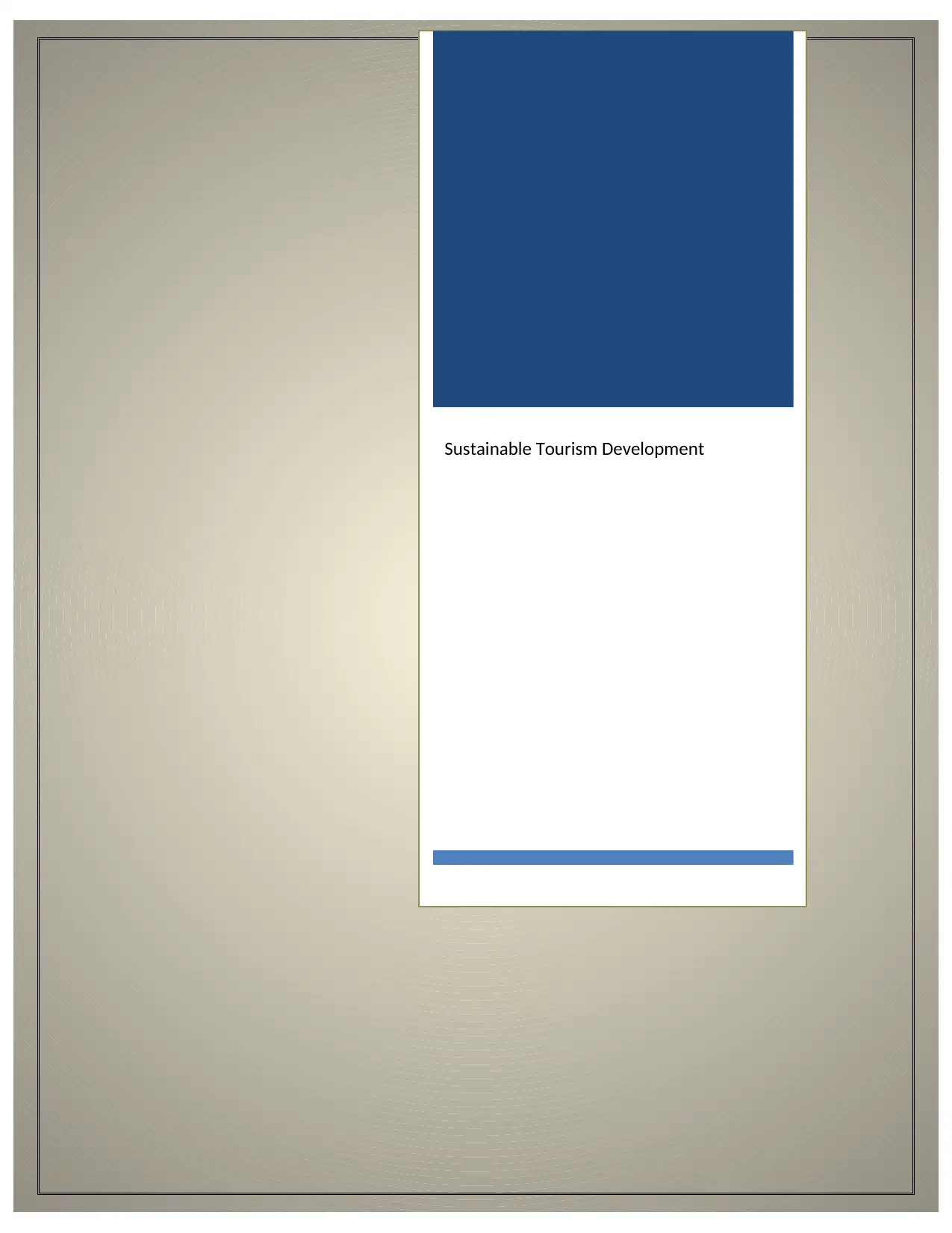
Sustainable Tourism Development
Paraphrase This Document
Need a fresh take? Get an instant paraphrase of this document with our AI Paraphraser
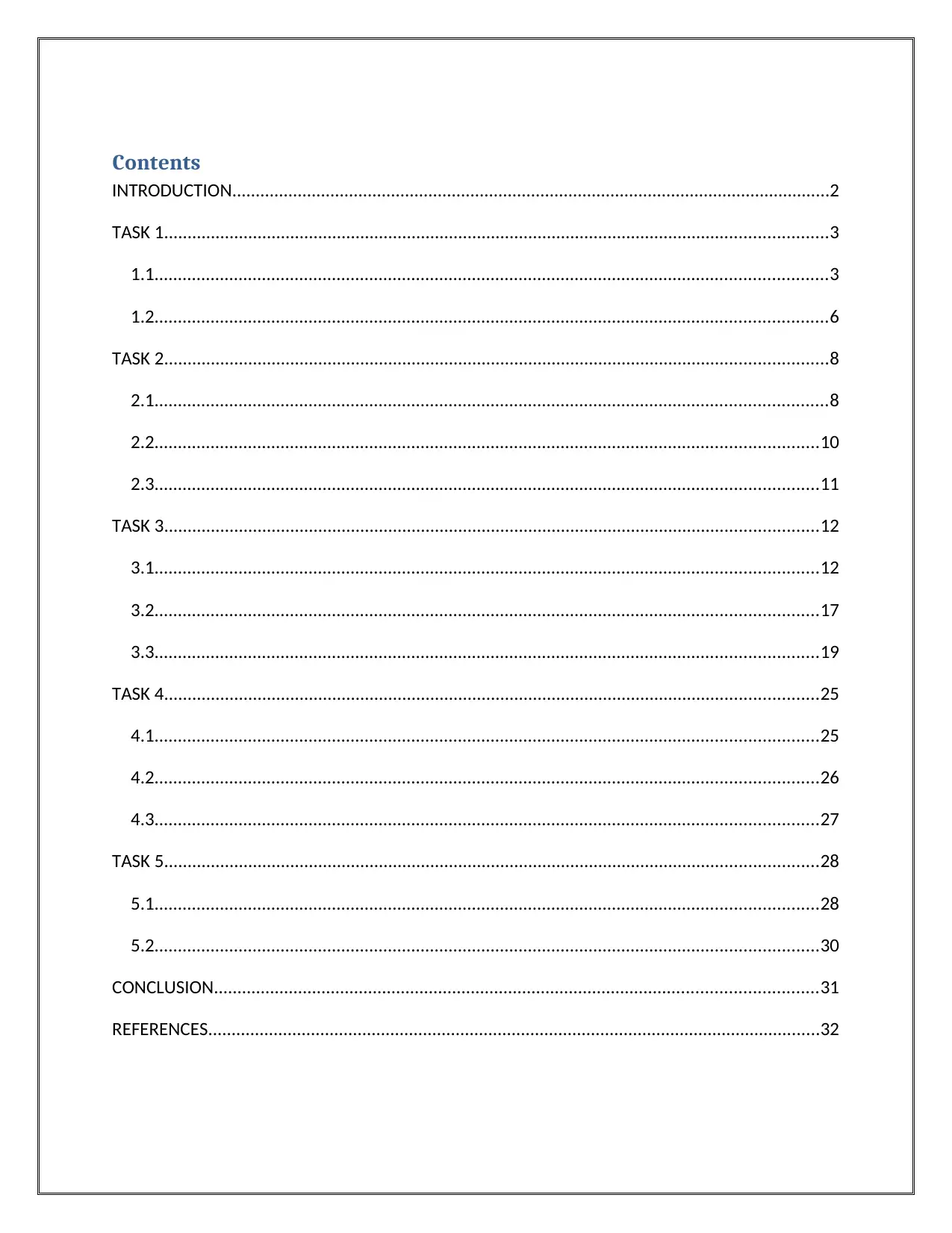
Contents
INTRODUCTION................................................................................................................................2
TASK 1..............................................................................................................................................3
1.1................................................................................................................................................3
1.2................................................................................................................................................6
TASK 2..............................................................................................................................................8
2.1................................................................................................................................................8
2.2..............................................................................................................................................10
2.3..............................................................................................................................................11
TASK 3............................................................................................................................................12
3.1..............................................................................................................................................12
3.2..............................................................................................................................................17
3.3..............................................................................................................................................19
TASK 4............................................................................................................................................25
4.1..............................................................................................................................................25
4.2..............................................................................................................................................26
4.3..............................................................................................................................................27
TASK 5............................................................................................................................................28
5.1..............................................................................................................................................28
5.2..............................................................................................................................................30
CONCLUSION.................................................................................................................................31
REFERENCES...................................................................................................................................32
INTRODUCTION................................................................................................................................2
TASK 1..............................................................................................................................................3
1.1................................................................................................................................................3
1.2................................................................................................................................................6
TASK 2..............................................................................................................................................8
2.1................................................................................................................................................8
2.2..............................................................................................................................................10
2.3..............................................................................................................................................11
TASK 3............................................................................................................................................12
3.1..............................................................................................................................................12
3.2..............................................................................................................................................17
3.3..............................................................................................................................................19
TASK 4............................................................................................................................................25
4.1..............................................................................................................................................25
4.2..............................................................................................................................................26
4.3..............................................................................................................................................27
TASK 5............................................................................................................................................28
5.1..............................................................................................................................................28
5.2..............................................................................................................................................30
CONCLUSION.................................................................................................................................31
REFERENCES...................................................................................................................................32

⊘ This is a preview!⊘
Do you want full access?
Subscribe today to unlock all pages.

Trusted by 1+ million students worldwide
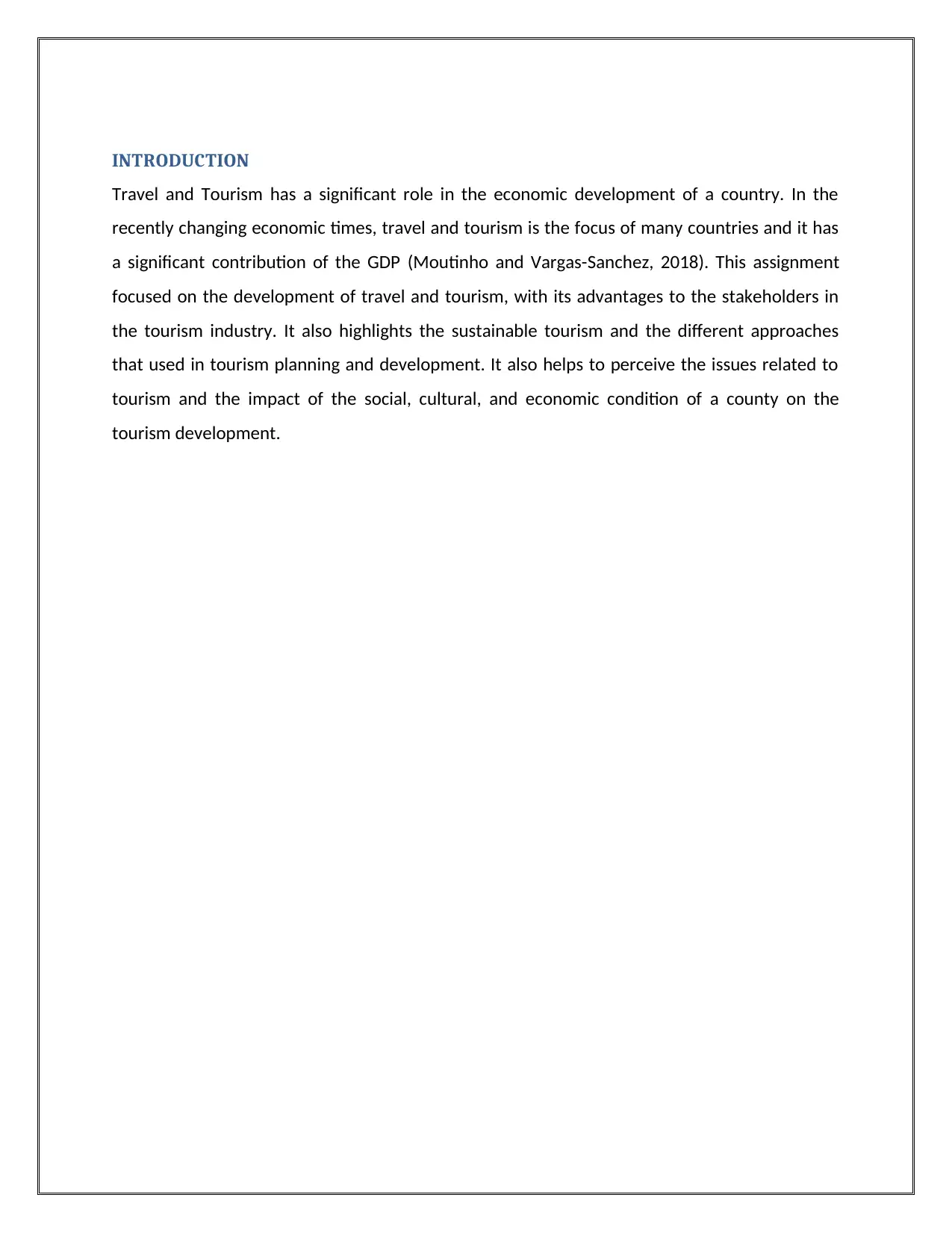
INTRODUCTION
Travel and Tourism has a significant role in the economic development of a country. In the
recently changing economic times, travel and tourism is the focus of many countries and it has
a significant contribution of the GDP (Moutinho and Vargas-Sanchez, 2018). This assignment
focused on the development of travel and tourism, with its advantages to the stakeholders in
the tourism industry. It also highlights the sustainable tourism and the different approaches
that used in tourism planning and development. It also helps to perceive the issues related to
tourism and the impact of the social, cultural, and economic condition of a county on the
tourism development.
Travel and Tourism has a significant role in the economic development of a country. In the
recently changing economic times, travel and tourism is the focus of many countries and it has
a significant contribution of the GDP (Moutinho and Vargas-Sanchez, 2018). This assignment
focused on the development of travel and tourism, with its advantages to the stakeholders in
the tourism industry. It also highlights the sustainable tourism and the different approaches
that used in tourism planning and development. It also helps to perceive the issues related to
tourism and the impact of the social, cultural, and economic condition of a county on the
tourism development.
Paraphrase This Document
Need a fresh take? Get an instant paraphrase of this document with our AI Paraphraser
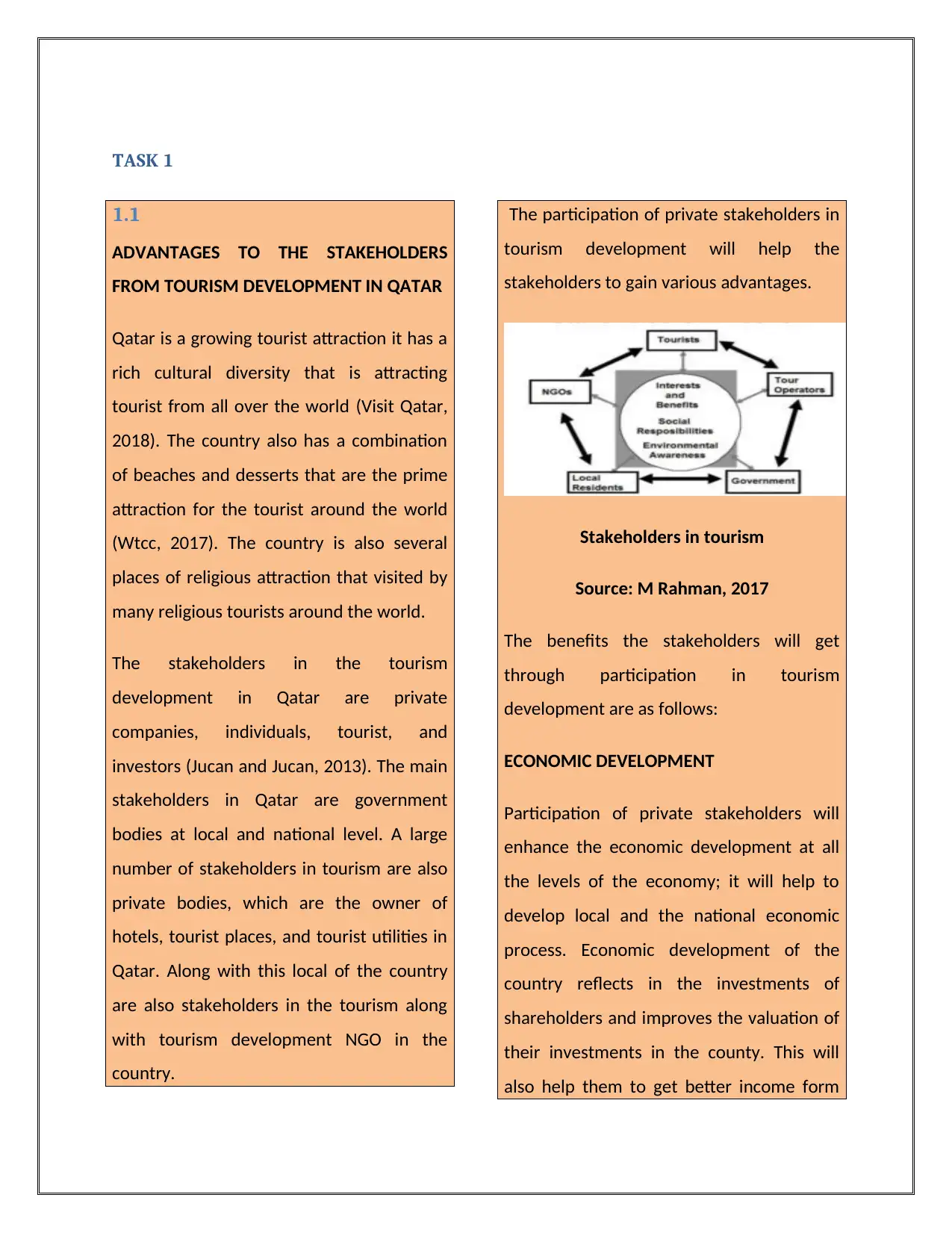
TASK 1
1.1
ADVANTAGES TO THE STAKEHOLDERS
FROM TOURISM DEVELOPMENT IN QATAR
Qatar is a growing tourist attraction it has a
rich cultural diversity that is attracting
tourist from all over the world (Visit Qatar,
2018). The country also has a combination
of beaches and desserts that are the prime
attraction for the tourist around the world
(Wtcc, 2017). The country is also several
places of religious attraction that visited by
many religious tourists around the world.
The stakeholders in the tourism
development in Qatar are private
companies, individuals, tourist, and
investors (Jucan and Jucan, 2013). The main
stakeholders in Qatar are government
bodies at local and national level. A large
number of stakeholders in tourism are also
private bodies, which are the owner of
hotels, tourist places, and tourist utilities in
Qatar. Along with this local of the country
are also stakeholders in the tourism along
with tourism development NGO in the
country.
The participation of private stakeholders in
tourism development will help the
stakeholders to gain various advantages.
Stakeholders in tourism
Source: M Rahman, 2017
The benefits the stakeholders will get
through participation in tourism
development are as follows:
ECONOMIC DEVELOPMENT
Participation of private stakeholders will
enhance the economic development at all
the levels of the economy; it will help to
develop local and the national economic
process. Economic development of the
country reflects in the investments of
shareholders and improves the valuation of
their investments in the county. This will
also help them to get better income form
1.1
ADVANTAGES TO THE STAKEHOLDERS
FROM TOURISM DEVELOPMENT IN QATAR
Qatar is a growing tourist attraction it has a
rich cultural diversity that is attracting
tourist from all over the world (Visit Qatar,
2018). The country also has a combination
of beaches and desserts that are the prime
attraction for the tourist around the world
(Wtcc, 2017). The country is also several
places of religious attraction that visited by
many religious tourists around the world.
The stakeholders in the tourism
development in Qatar are private
companies, individuals, tourist, and
investors (Jucan and Jucan, 2013). The main
stakeholders in Qatar are government
bodies at local and national level. A large
number of stakeholders in tourism are also
private bodies, which are the owner of
hotels, tourist places, and tourist utilities in
Qatar. Along with this local of the country
are also stakeholders in the tourism along
with tourism development NGO in the
country.
The participation of private stakeholders in
tourism development will help the
stakeholders to gain various advantages.
Stakeholders in tourism
Source: M Rahman, 2017
The benefits the stakeholders will get
through participation in tourism
development are as follows:
ECONOMIC DEVELOPMENT
Participation of private stakeholders will
enhance the economic development at all
the levels of the economy; it will help to
develop local and the national economic
process. Economic development of the
country reflects in the investments of
shareholders and improves the valuation of
their investments in the county. This will
also help them to get better income form
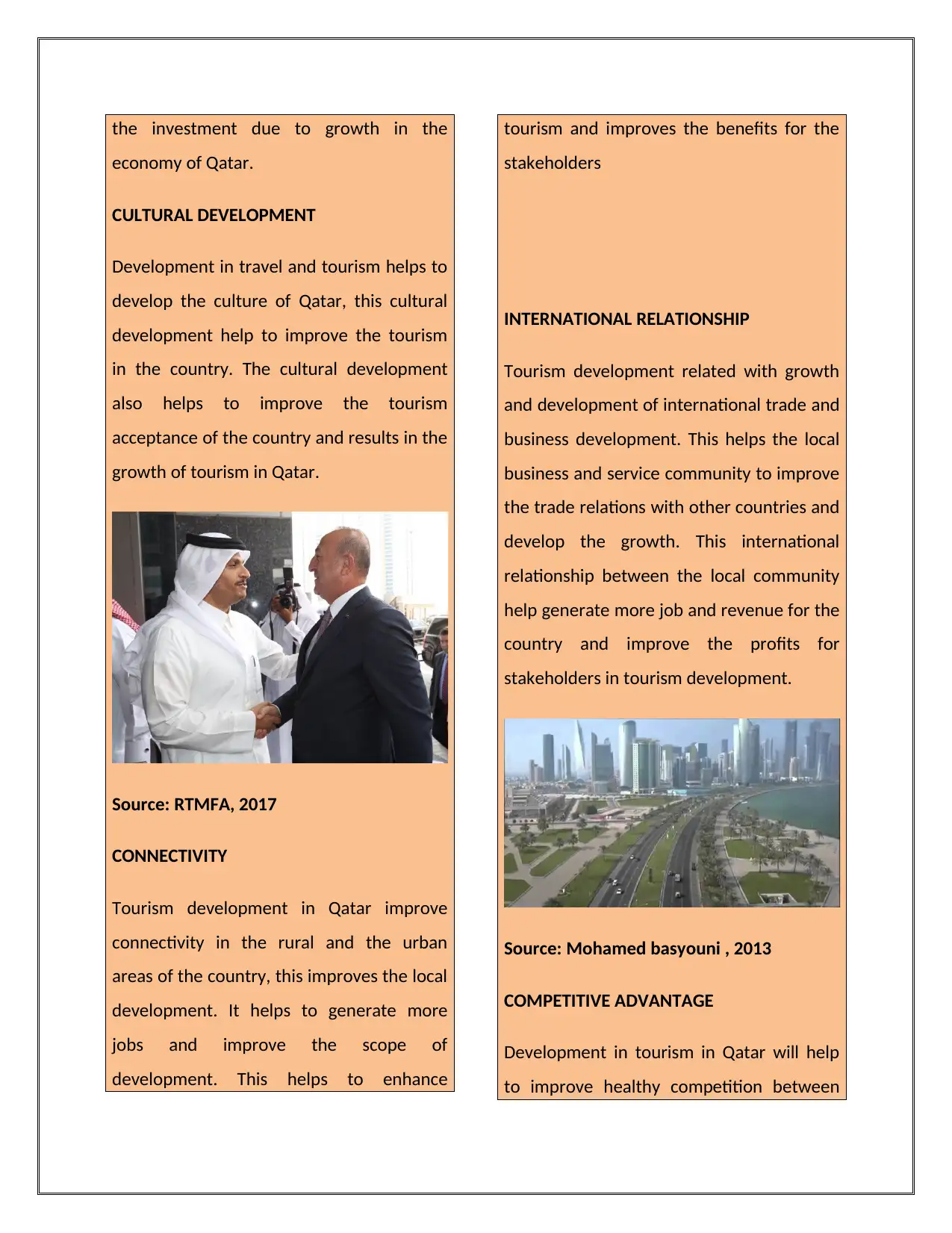
the investment due to growth in the
economy of Qatar.
CULTURAL DEVELOPMENT
Development in travel and tourism helps to
develop the culture of Qatar, this cultural
development help to improve the tourism
in the country. The cultural development
also helps to improve the tourism
acceptance of the country and results in the
growth of tourism in Qatar.
Source: RTMFA, 2017
CONNECTIVITY
Tourism development in Qatar improve
connectivity in the rural and the urban
areas of the country, this improves the local
development. It helps to generate more
jobs and improve the scope of
development. This helps to enhance
tourism and improves the benefits for the
stakeholders
INTERNATIONAL RELATIONSHIP
Tourism development related with growth
and development of international trade and
business development. This helps the local
business and service community to improve
the trade relations with other countries and
develop the growth. This international
relationship between the local community
help generate more job and revenue for the
country and improve the profits for
stakeholders in tourism development.
Source: Mohamed basyouni , 2013
COMPETITIVE ADVANTAGE
Development in tourism in Qatar will help
to improve healthy competition between
economy of Qatar.
CULTURAL DEVELOPMENT
Development in travel and tourism helps to
develop the culture of Qatar, this cultural
development help to improve the tourism
in the country. The cultural development
also helps to improve the tourism
acceptance of the country and results in the
growth of tourism in Qatar.
Source: RTMFA, 2017
CONNECTIVITY
Tourism development in Qatar improve
connectivity in the rural and the urban
areas of the country, this improves the local
development. It helps to generate more
jobs and improve the scope of
development. This helps to enhance
tourism and improves the benefits for the
stakeholders
INTERNATIONAL RELATIONSHIP
Tourism development related with growth
and development of international trade and
business development. This helps the local
business and service community to improve
the trade relations with other countries and
develop the growth. This international
relationship between the local community
help generate more job and revenue for the
country and improve the profits for
stakeholders in tourism development.
Source: Mohamed basyouni , 2013
COMPETITIVE ADVANTAGE
Development in tourism in Qatar will help
to improve healthy competition between
⊘ This is a preview!⊘
Do you want full access?
Subscribe today to unlock all pages.

Trusted by 1+ million students worldwide
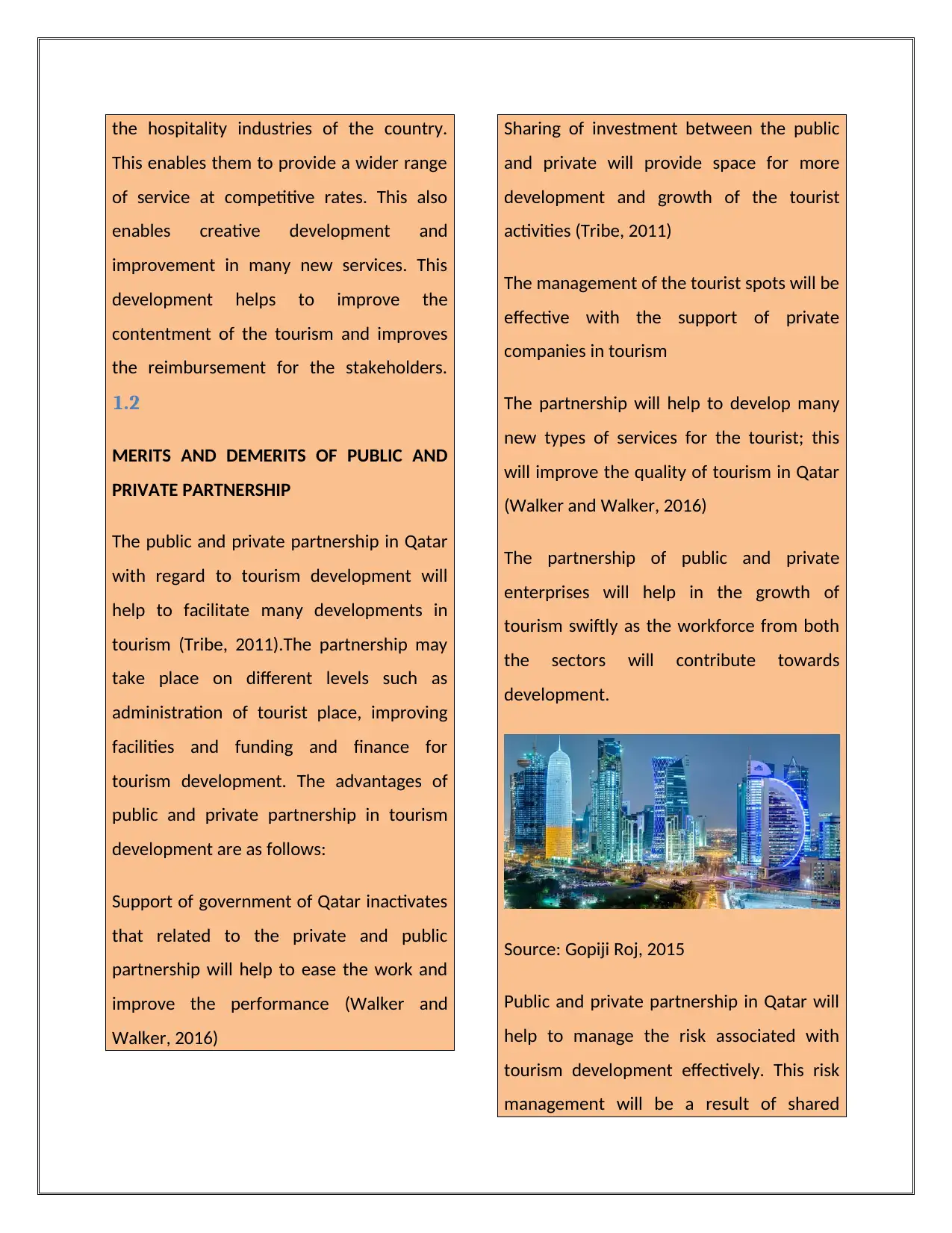
the hospitality industries of the country.
This enables them to provide a wider range
of service at competitive rates. This also
enables creative development and
improvement in many new services. This
development helps to improve the
contentment of the tourism and improves
the reimbursement for the stakeholders.
1.2
MERITS AND DEMERITS OF PUBLIC AND
PRIVATE PARTNERSHIP
The public and private partnership in Qatar
with regard to tourism development will
help to facilitate many developments in
tourism (Tribe, 2011).The partnership may
take place on different levels such as
administration of tourist place, improving
facilities and funding and finance for
tourism development. The advantages of
public and private partnership in tourism
development are as follows:
Support of government of Qatar inactivates
that related to the private and public
partnership will help to ease the work and
improve the performance (Walker and
Walker, 2016)
Sharing of investment between the public
and private will provide space for more
development and growth of the tourist
activities (Tribe, 2011)
The management of the tourist spots will be
effective with the support of private
companies in tourism
The partnership will help to develop many
new types of services for the tourist; this
will improve the quality of tourism in Qatar
(Walker and Walker, 2016)
The partnership of public and private
enterprises will help in the growth of
tourism swiftly as the workforce from both
the sectors will contribute towards
development.
Source: Gopiji Roj, 2015
Public and private partnership in Qatar will
help to manage the risk associated with
tourism development effectively. This risk
management will be a result of shared
This enables them to provide a wider range
of service at competitive rates. This also
enables creative development and
improvement in many new services. This
development helps to improve the
contentment of the tourism and improves
the reimbursement for the stakeholders.
1.2
MERITS AND DEMERITS OF PUBLIC AND
PRIVATE PARTNERSHIP
The public and private partnership in Qatar
with regard to tourism development will
help to facilitate many developments in
tourism (Tribe, 2011).The partnership may
take place on different levels such as
administration of tourist place, improving
facilities and funding and finance for
tourism development. The advantages of
public and private partnership in tourism
development are as follows:
Support of government of Qatar inactivates
that related to the private and public
partnership will help to ease the work and
improve the performance (Walker and
Walker, 2016)
Sharing of investment between the public
and private will provide space for more
development and growth of the tourist
activities (Tribe, 2011)
The management of the tourist spots will be
effective with the support of private
companies in tourism
The partnership will help to develop many
new types of services for the tourist; this
will improve the quality of tourism in Qatar
(Walker and Walker, 2016)
The partnership of public and private
enterprises will help in the growth of
tourism swiftly as the workforce from both
the sectors will contribute towards
development.
Source: Gopiji Roj, 2015
Public and private partnership in Qatar will
help to manage the risk associated with
tourism development effectively. This risk
management will be a result of shared
Paraphrase This Document
Need a fresh take? Get an instant paraphrase of this document with our AI Paraphraser
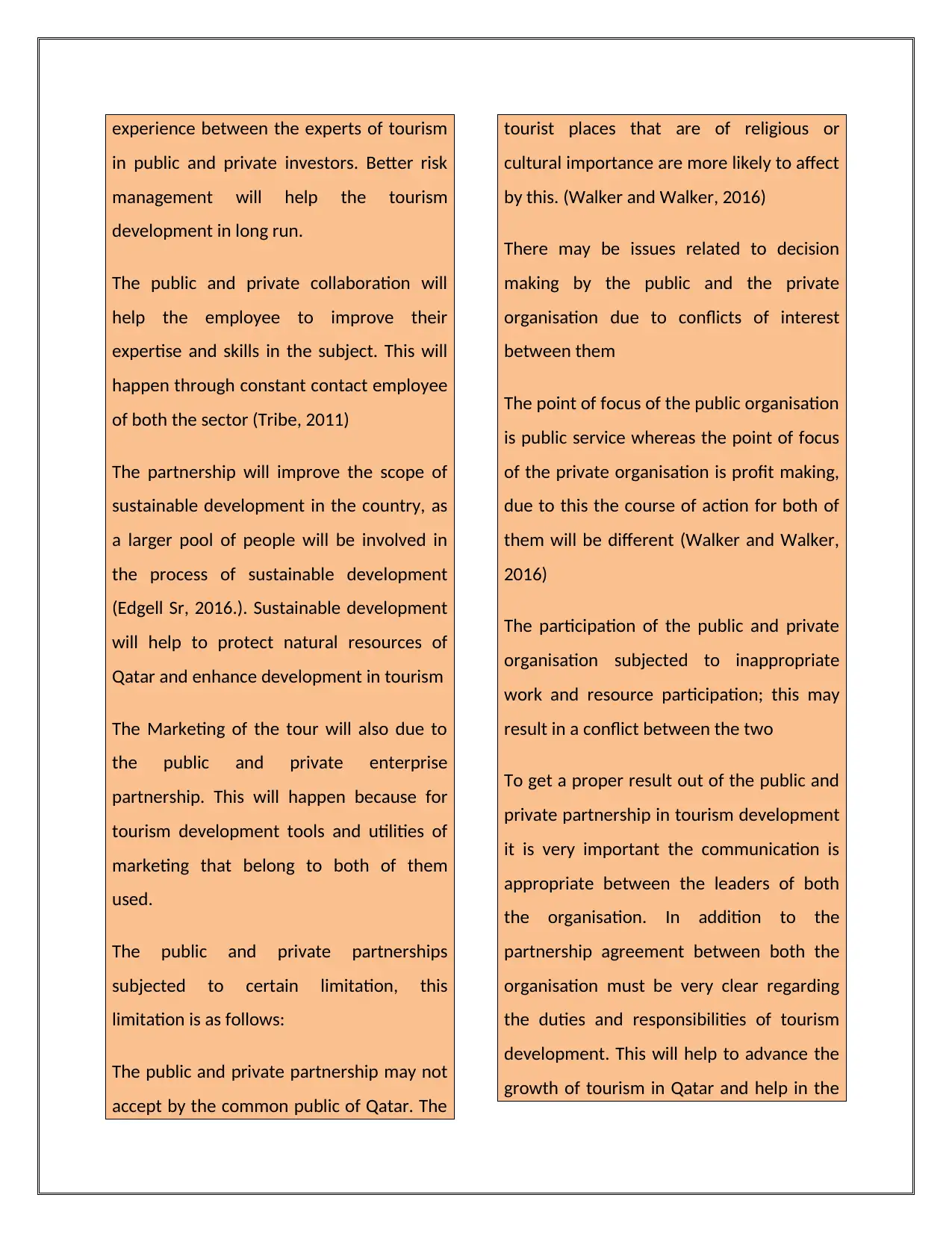
experience between the experts of tourism
in public and private investors. Better risk
management will help the tourism
development in long run.
The public and private collaboration will
help the employee to improve their
expertise and skills in the subject. This will
happen through constant contact employee
of both the sector (Tribe, 2011)
The partnership will improve the scope of
sustainable development in the country, as
a larger pool of people will be involved in
the process of sustainable development
(Edgell Sr, 2016.). Sustainable development
will help to protect natural resources of
Qatar and enhance development in tourism
The Marketing of the tour will also due to
the public and private enterprise
partnership. This will happen because for
tourism development tools and utilities of
marketing that belong to both of them
used.
The public and private partnerships
subjected to certain limitation, this
limitation is as follows:
The public and private partnership may not
accept by the common public of Qatar. The
tourist places that are of religious or
cultural importance are more likely to affect
by this. (Walker and Walker, 2016)
There may be issues related to decision
making by the public and the private
organisation due to conflicts of interest
between them
The point of focus of the public organisation
is public service whereas the point of focus
of the private organisation is profit making,
due to this the course of action for both of
them will be different (Walker and Walker,
2016)
The participation of the public and private
organisation subjected to inappropriate
work and resource participation; this may
result in a conflict between the two
To get a proper result out of the public and
private partnership in tourism development
it is very important the communication is
appropriate between the leaders of both
the organisation. In addition to the
partnership agreement between both the
organisation must be very clear regarding
the duties and responsibilities of tourism
development. This will help to advance the
growth of tourism in Qatar and help in the
in public and private investors. Better risk
management will help the tourism
development in long run.
The public and private collaboration will
help the employee to improve their
expertise and skills in the subject. This will
happen through constant contact employee
of both the sector (Tribe, 2011)
The partnership will improve the scope of
sustainable development in the country, as
a larger pool of people will be involved in
the process of sustainable development
(Edgell Sr, 2016.). Sustainable development
will help to protect natural resources of
Qatar and enhance development in tourism
The Marketing of the tour will also due to
the public and private enterprise
partnership. This will happen because for
tourism development tools and utilities of
marketing that belong to both of them
used.
The public and private partnerships
subjected to certain limitation, this
limitation is as follows:
The public and private partnership may not
accept by the common public of Qatar. The
tourist places that are of religious or
cultural importance are more likely to affect
by this. (Walker and Walker, 2016)
There may be issues related to decision
making by the public and the private
organisation due to conflicts of interest
between them
The point of focus of the public organisation
is public service whereas the point of focus
of the private organisation is profit making,
due to this the course of action for both of
them will be different (Walker and Walker,
2016)
The participation of the public and private
organisation subjected to inappropriate
work and resource participation; this may
result in a conflict between the two
To get a proper result out of the public and
private partnership in tourism development
it is very important the communication is
appropriate between the leaders of both
the organisation. In addition to the
partnership agreement between both the
organisation must be very clear regarding
the duties and responsibilities of tourism
development. This will help to advance the
growth of tourism in Qatar and help in the
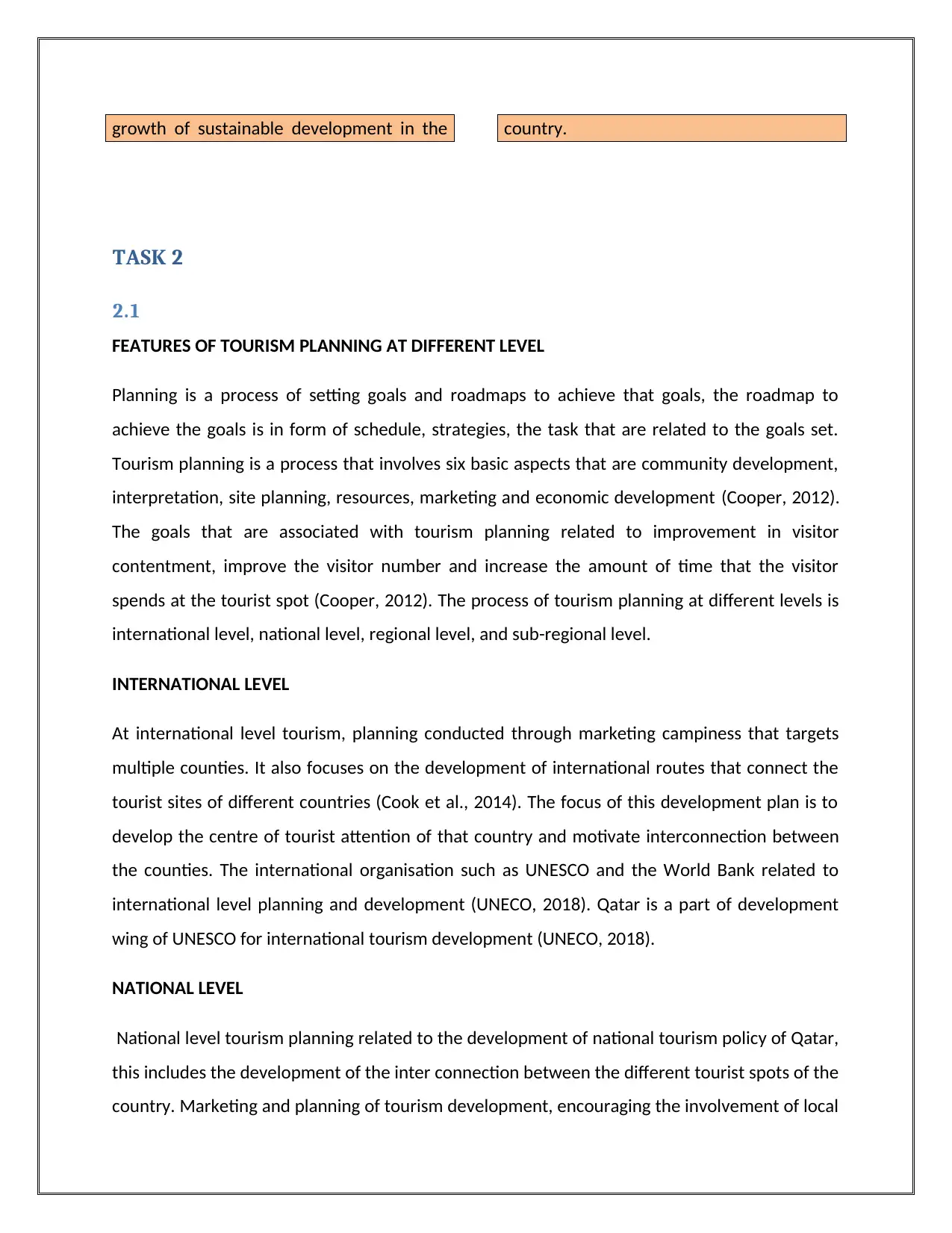
growth of sustainable development in the country.
TASK 2
2.1
FEATURES OF TOURISM PLANNING AT DIFFERENT LEVEL
Planning is a process of setting goals and roadmaps to achieve that goals, the roadmap to
achieve the goals is in form of schedule, strategies, the task that are related to the goals set.
Tourism planning is a process that involves six basic aspects that are community development,
interpretation, site planning, resources, marketing and economic development (Cooper, 2012).
The goals that are associated with tourism planning related to improvement in visitor
contentment, improve the visitor number and increase the amount of time that the visitor
spends at the tourist spot (Cooper, 2012). The process of tourism planning at different levels is
international level, national level, regional level, and sub-regional level.
INTERNATIONAL LEVEL
At international level tourism, planning conducted through marketing campiness that targets
multiple counties. It also focuses on the development of international routes that connect the
tourist sites of different countries (Cook et al., 2014). The focus of this development plan is to
develop the centre of tourist attention of that country and motivate interconnection between
the counties. The international organisation such as UNESCO and the World Bank related to
international level planning and development (UNECO, 2018). Qatar is a part of development
wing of UNESCO for international tourism development (UNECO, 2018).
NATIONAL LEVEL
National level tourism planning related to the development of national tourism policy of Qatar,
this includes the development of the inter connection between the different tourist spots of the
country. Marketing and planning of tourism development, encouraging the involvement of local
TASK 2
2.1
FEATURES OF TOURISM PLANNING AT DIFFERENT LEVEL
Planning is a process of setting goals and roadmaps to achieve that goals, the roadmap to
achieve the goals is in form of schedule, strategies, the task that are related to the goals set.
Tourism planning is a process that involves six basic aspects that are community development,
interpretation, site planning, resources, marketing and economic development (Cooper, 2012).
The goals that are associated with tourism planning related to improvement in visitor
contentment, improve the visitor number and increase the amount of time that the visitor
spends at the tourist spot (Cooper, 2012). The process of tourism planning at different levels is
international level, national level, regional level, and sub-regional level.
INTERNATIONAL LEVEL
At international level tourism, planning conducted through marketing campiness that targets
multiple counties. It also focuses on the development of international routes that connect the
tourist sites of different countries (Cook et al., 2014). The focus of this development plan is to
develop the centre of tourist attention of that country and motivate interconnection between
the counties. The international organisation such as UNESCO and the World Bank related to
international level planning and development (UNECO, 2018). Qatar is a part of development
wing of UNESCO for international tourism development (UNECO, 2018).
NATIONAL LEVEL
National level tourism planning related to the development of national tourism policy of Qatar,
this includes the development of the inter connection between the different tourist spots of the
country. Marketing and planning of tourism development, encouraging the involvement of local
⊘ This is a preview!⊘
Do you want full access?
Subscribe today to unlock all pages.

Trusted by 1+ million students worldwide
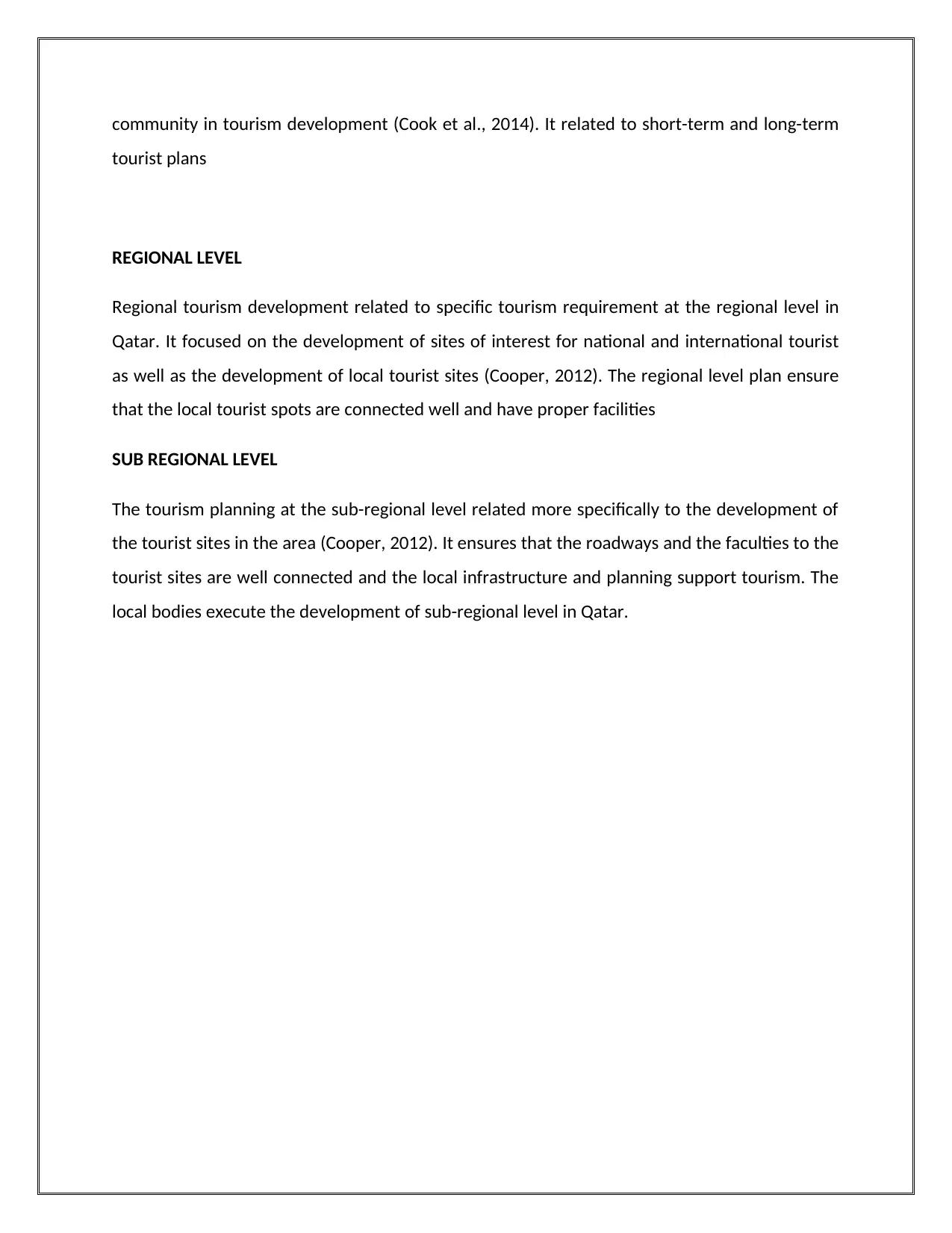
community in tourism development (Cook et al., 2014). It related to short-term and long-term
tourist plans
REGIONAL LEVEL
Regional tourism development related to specific tourism requirement at the regional level in
Qatar. It focused on the development of sites of interest for national and international tourist
as well as the development of local tourist sites (Cooper, 2012). The regional level plan ensure
that the local tourist spots are connected well and have proper facilities
SUB REGIONAL LEVEL
The tourism planning at the sub-regional level related more specifically to the development of
the tourist sites in the area (Cooper, 2012). It ensures that the roadways and the faculties to the
tourist sites are well connected and the local infrastructure and planning support tourism. The
local bodies execute the development of sub-regional level in Qatar.
tourist plans
REGIONAL LEVEL
Regional tourism development related to specific tourism requirement at the regional level in
Qatar. It focused on the development of sites of interest for national and international tourist
as well as the development of local tourist sites (Cooper, 2012). The regional level plan ensure
that the local tourist spots are connected well and have proper facilities
SUB REGIONAL LEVEL
The tourism planning at the sub-regional level related more specifically to the development of
the tourist sites in the area (Cooper, 2012). It ensures that the roadways and the faculties to the
tourist sites are well connected and the local infrastructure and planning support tourism. The
local bodies execute the development of sub-regional level in Qatar.
Paraphrase This Document
Need a fresh take? Get an instant paraphrase of this document with our AI Paraphraser
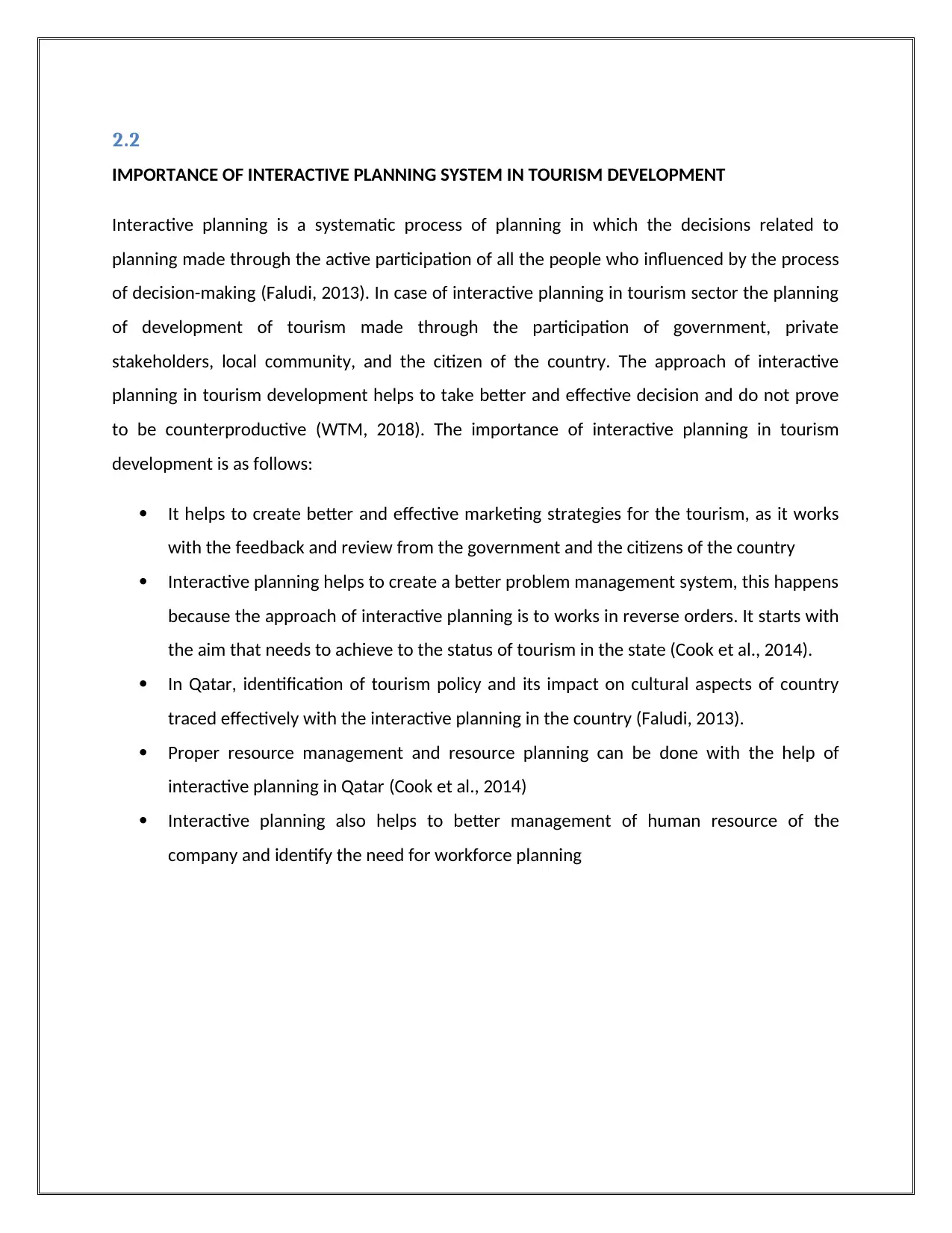
2.2
IMPORTANCE OF INTERACTIVE PLANNING SYSTEM IN TOURISM DEVELOPMENT
Interactive planning is a systematic process of planning in which the decisions related to
planning made through the active participation of all the people who influenced by the process
of decision-making (Faludi, 2013). In case of interactive planning in tourism sector the planning
of development of tourism made through the participation of government, private
stakeholders, local community, and the citizen of the country. The approach of interactive
planning in tourism development helps to take better and effective decision and do not prove
to be counterproductive (WTM, 2018). The importance of interactive planning in tourism
development is as follows:
It helps to create better and effective marketing strategies for the tourism, as it works
with the feedback and review from the government and the citizens of the country
Interactive planning helps to create a better problem management system, this happens
because the approach of interactive planning is to works in reverse orders. It starts with
the aim that needs to achieve to the status of tourism in the state (Cook et al., 2014).
In Qatar, identification of tourism policy and its impact on cultural aspects of country
traced effectively with the interactive planning in the country (Faludi, 2013).
Proper resource management and resource planning can be done with the help of
interactive planning in Qatar (Cook et al., 2014)
Interactive planning also helps to better management of human resource of the
company and identify the need for workforce planning
IMPORTANCE OF INTERACTIVE PLANNING SYSTEM IN TOURISM DEVELOPMENT
Interactive planning is a systematic process of planning in which the decisions related to
planning made through the active participation of all the people who influenced by the process
of decision-making (Faludi, 2013). In case of interactive planning in tourism sector the planning
of development of tourism made through the participation of government, private
stakeholders, local community, and the citizen of the country. The approach of interactive
planning in tourism development helps to take better and effective decision and do not prove
to be counterproductive (WTM, 2018). The importance of interactive planning in tourism
development is as follows:
It helps to create better and effective marketing strategies for the tourism, as it works
with the feedback and review from the government and the citizens of the country
Interactive planning helps to create a better problem management system, this happens
because the approach of interactive planning is to works in reverse orders. It starts with
the aim that needs to achieve to the status of tourism in the state (Cook et al., 2014).
In Qatar, identification of tourism policy and its impact on cultural aspects of country
traced effectively with the interactive planning in the country (Faludi, 2013).
Proper resource management and resource planning can be done with the help of
interactive planning in Qatar (Cook et al., 2014)
Interactive planning also helps to better management of human resource of the
company and identify the need for workforce planning
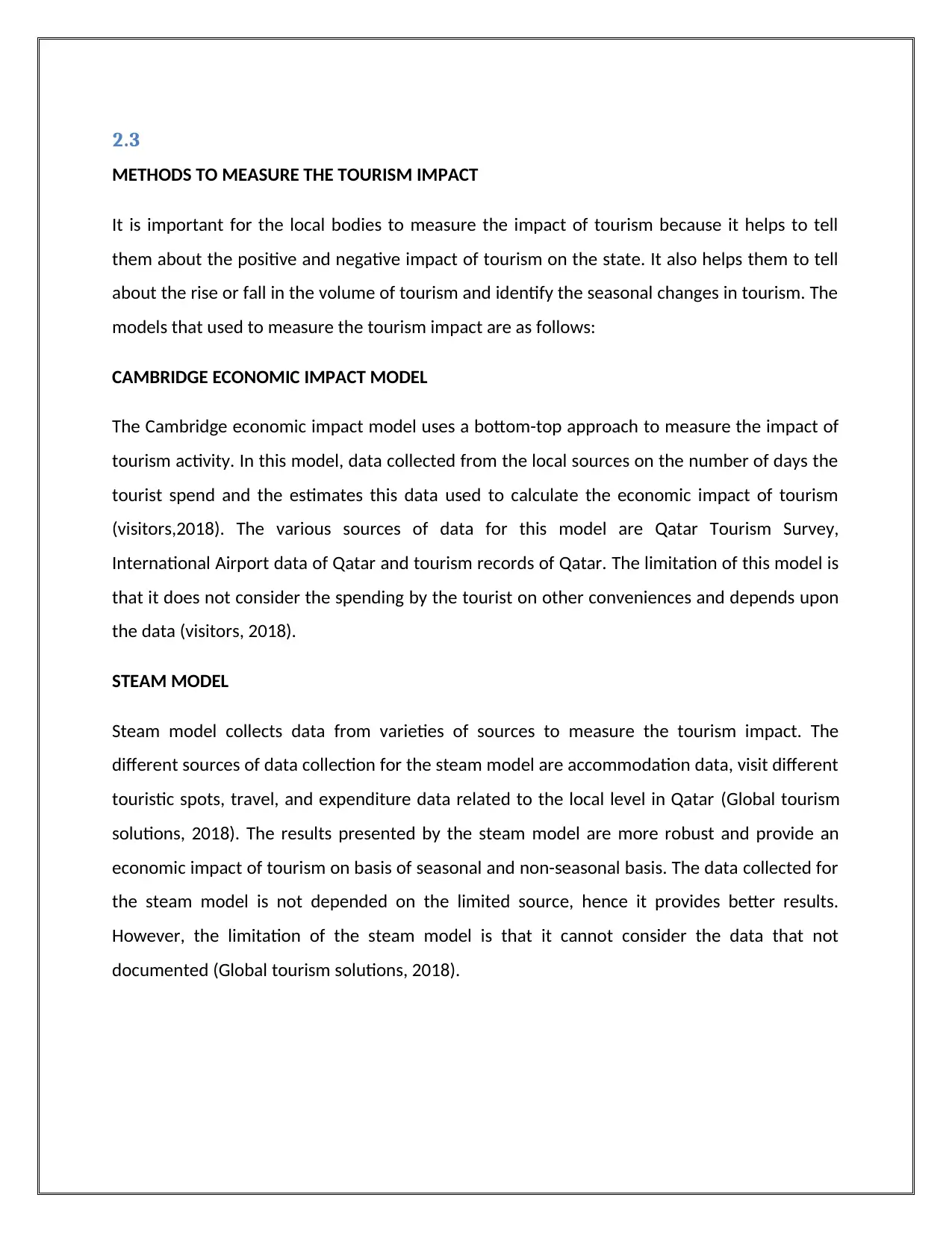
2.3
METHODS TO MEASURE THE TOURISM IMPACT
It is important for the local bodies to measure the impact of tourism because it helps to tell
them about the positive and negative impact of tourism on the state. It also helps them to tell
about the rise or fall in the volume of tourism and identify the seasonal changes in tourism. The
models that used to measure the tourism impact are as follows:
CAMBRIDGE ECONOMIC IMPACT MODEL
The Cambridge economic impact model uses a bottom-top approach to measure the impact of
tourism activity. In this model, data collected from the local sources on the number of days the
tourist spend and the estimates this data used to calculate the economic impact of tourism
(visitors,2018). The various sources of data for this model are Qatar Tourism Survey,
International Airport data of Qatar and tourism records of Qatar. The limitation of this model is
that it does not consider the spending by the tourist on other conveniences and depends upon
the data (visitors, 2018).
STEAM MODEL
Steam model collects data from varieties of sources to measure the tourism impact. The
different sources of data collection for the steam model are accommodation data, visit different
touristic spots, travel, and expenditure data related to the local level in Qatar (Global tourism
solutions, 2018). The results presented by the steam model are more robust and provide an
economic impact of tourism on basis of seasonal and non-seasonal basis. The data collected for
the steam model is not depended on the limited source, hence it provides better results.
However, the limitation of the steam model is that it cannot consider the data that not
documented (Global tourism solutions, 2018).
METHODS TO MEASURE THE TOURISM IMPACT
It is important for the local bodies to measure the impact of tourism because it helps to tell
them about the positive and negative impact of tourism on the state. It also helps them to tell
about the rise or fall in the volume of tourism and identify the seasonal changes in tourism. The
models that used to measure the tourism impact are as follows:
CAMBRIDGE ECONOMIC IMPACT MODEL
The Cambridge economic impact model uses a bottom-top approach to measure the impact of
tourism activity. In this model, data collected from the local sources on the number of days the
tourist spend and the estimates this data used to calculate the economic impact of tourism
(visitors,2018). The various sources of data for this model are Qatar Tourism Survey,
International Airport data of Qatar and tourism records of Qatar. The limitation of this model is
that it does not consider the spending by the tourist on other conveniences and depends upon
the data (visitors, 2018).
STEAM MODEL
Steam model collects data from varieties of sources to measure the tourism impact. The
different sources of data collection for the steam model are accommodation data, visit different
touristic spots, travel, and expenditure data related to the local level in Qatar (Global tourism
solutions, 2018). The results presented by the steam model are more robust and provide an
economic impact of tourism on basis of seasonal and non-seasonal basis. The data collected for
the steam model is not depended on the limited source, hence it provides better results.
However, the limitation of the steam model is that it cannot consider the data that not
documented (Global tourism solutions, 2018).
⊘ This is a preview!⊘
Do you want full access?
Subscribe today to unlock all pages.

Trusted by 1+ million students worldwide
1 out of 34
Related Documents
Your All-in-One AI-Powered Toolkit for Academic Success.
+13062052269
info@desklib.com
Available 24*7 on WhatsApp / Email
![[object Object]](/_next/static/media/star-bottom.7253800d.svg)
Unlock your academic potential
Copyright © 2020–2025 A2Z Services. All Rights Reserved. Developed and managed by ZUCOL.



